Towards Assertive Community Care
Abstract
|
Assertive Community Treatment (ACT) refers to a loosely related set of principles and practices focused on improving the lot of those identified as
"heavy service users", or those people who have historically been difficult to engage in treatment. A burgeoning body of research testifies to the effectiveness of ACT and a bewildering number of acronyms such as
PACT, MIT,
MCT, TCL and MST have been coined to describe services more or less faithful to ACT principles.This paper describes the key principles of
ACT, research on outcomes and ACT programmes, presents a sketch of the Mobile Intensive Treatment Team in Townsville and critiques ACT from an ethical perspective. It proposes that ACT ought to commence from a philosophy of community mental health firmly grounded in respect for
people, and ought to be the primary business of community mental health services. |
|
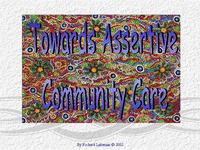 |
Contents
Introduction 
ACT may best be conceptualised as a "middle way" of psychiatric service
provision, neither passively neglecting the individual with mental illness nor aggressively riding rough shod over his or her human rights to enforce treatment. ACT is a return to the traditional values of sound nursing or human
service, founded on respect, human engagement, and which is orientated towards facilitating the right conditions for growth and development. The success or otherwise of ACT is largely dependent on the capacity for individual clinicians to engage in a meaningful helping
relationship, to build on the strengths of the individual and community, and to assist in the negotiation of problems of everyday living.
Defining an ACT programme 
Public mental health services and mental health professionals may have many faults but a questionable strength is the capacity to create pithy acronyms to name and describe what they do. Assertive community treatment or ACT is a trendy
acronym, which can lead to confusion in part because it is synonymous with many other terms and embodied in many mental health programmes. It is a term that encompasses a range of principles and
practices, which are more or less synonymous with:
-
Assertive Case Management
-
Intensive Case Management
-
Intensive Community Care
-
Assertive Outreach
Mental health programmes more or less faithful to ACT principles include:
-
Training in Community Living Program
-
Program for Assertive Community Treatment (PACT)
-
Mobile intensive Treatment Teams (MITT)
-
Mobile Intensive Support Teams (MIST)
-
Mobile Community Management Teams (MCMT)
Some have even suggested that clinical case management is synonymous with ACT (Burns,
1997), which is particularly problematic given that ACT is frequently compared and contrasted with variations of clinical case management.
ACT is a form of case management, but the very term Ďcase managementí
is confusing and various typographies exist to describe variations in types of
case management. Diamond and Kantor have referred to the varieties as:
 |
|
-
The
travel agent model Ė where the professional sits behind the desk
offering advice. This is described by others as the "brokerage
model".
-
The travel companion model where someone goes with you but without
any special expertise or training; and
-
The
travel guide model Ė where a person will not only be there,
and do things with you, but also has appropriate training,
experience and expertise to know the most scenic routes, how to take
short cuts without getting lost, how to reliably avoid the pitfalls
and how to arrive safely at the destination.
|
Australasian mental health case management draws on all these models but
has most in common with the travel guide model.
There is considerable variation between ACT programmes and some disagreement on the components that are critical to success.
However, most services share the following features:
- Services are targeted to clients who have traditionally been poorly served by inflexible systems of care e.g. heavy service
users, the
"seriously mentally ill".
- Treatment, support and rehabilitation services are provided directly by the ACT team rather than brokered to external agencies.
- "Outreach" or mobile services are provided and tend to be carried out where problems
occur, in the personís home or other community setting rather than in hospital or clinic settings.
- The staff to client ratio is small (1 to 10) and team members share responsibility for the individuals served by the team.
- Treatment and support services are individualized and flexible with the case manager participating in the everyday life of the client e.g. through assisting with
transport, accompanying shopping etc.
- Services are available 24 hours a day.
∑
- Clients are contacted frequently (usually more than weekly) and engagement is
assertive, that is the client is contacted even if ambivalent or negative.
∑
- Services are provided for as long as support or treatment is required.
The history of ACT 
The "training in community living program" developed during the 1970s as an alternative to mental hospital
treatment, is widely accepted as the first model of assertive community treatment
(Dixon, 2000). The programme evolved out of work credited to Arnold Marx, Leonard Stein and Mary Ann Test at the Mendota Mental Health Institute in
Madison, Wisconsin. Its aims were similar to the aims of most community mental health teams
today, that is, to enhance patientís community adjustment, decrease time spent in
institutions, and ultimately to prevent the development of the chronic patient role. Additionally the program focuses on decreasing patientsí symptomatology and increasing their self-esteem and satisfaction with life.
(Gold Award, 2000, p.6).
In order to meet these goals substantial human resources were committed to provide whatever assistance people needed in order to live in the
community, e.g. assisting with securing accommodation, finding employment,
budgeting, shopping, and personal care. Services were provided in two shifts, with one staff member being on call at
night, seven days a week. The training in community living programme eventually evolved into the Program of Assertive Community Treatment
(PACT), a reasonably standardised service that is popular in the United States today.
Hoult, Reynolds, Charbonneau-Powis, Coles, and Briggs (1981) are credited with being responsible for introducing a variation of ACT to Australia and demonstrating the feasibility of providing assertive treatment by mobile community teams with the back up of crisis services as a viable alternative to in-patient care without significantly increasing care-giver burden. Since then Mobile Intensive Treatment or Support Teams has become part of the mental health service landscape in Australia.
Today ACT as a system of care, whilst not available universally to those who might benefit from it is being promoted as standard practice
(Phillips et al., 2001). Burns (2001) suggests that the UK is awash with outreach programmes. In the United States ACT programmes have been implemented in 35 states
(Phillips et al., 2001) and the National Alliance for the Mentally Ill (NAMI) aims to have PACT programmes operating in every state by 2002
(Carolla, 1998). Adaptations of ACT have been implemented in Europe and Canada (Phillips et
al., 2001), Australia and New Zealand. ACT principles are being employed in the establishment and development of general community mental health teams and services targeting groups such as those with recent onset of
illness, concurrent drug related problems and mental illness, the homeless, forensic or hard to engage patients
(Burns, 2001).
Benefits of ACT
Assertive Community Treatment is one of the most well evaluated and documented non-pharmaceutical mental health interventions. Many substantial reviews of ACT have been undertaken. The most recent Cochrane Review
(Marshall & Lockwood, 2000) concluded that compared to standard community care people allocated to ACT were:
-
More likely to remain in contact with services
-
Less likely to be admitted to hospital and when admitted spend less time in hospital
-
More likely to be living independently
-
More likely to have found employment
-
More satisfied with the service they receive.
There were no differences between ACT and control treatments on mental state or social functioning
(Marshall & Lockwood, 2000).
In contrast the Cochrane Review examining general case management for people with severe mental illness presented some scathing criticisms
(Marshall, Gray, Lockwood, & Green, 2000). The review found that case management approximately doubled the rate of hospital admissions with little evidence of improvement in mental
state, social functioning or quality of life. It conclude that
... case management is an intervention of questionable
value, to the extent that it is doubtful whether it should be offered by community psychiatric services. It is hard to see how policy makers who subscribe to an evidence-based approach can justify retaining case management as 'the cornerstone' of community mental health care.
(Marshall et al., 2000)
Ziguras and Stuart (2000) undertook a meta-analysis of controlled trials examining the effectiveness of case management over 20 years and had a more liberal approach to study inclusion than the Cochrane Review. They examined 44
studies, 9 of which directly compared ACT with clinical case management and 35 compared ACT or clinical case management with usual treatment. Both types of case management were found to:
-
reduce family burden,
-
increase family and client satisfaction with services,
-
reduce the overall cost of care,
-
reduce symptoms
increase client contact with services,
- and reduce dropout rates
improve social functioning.
ACT was found to reduce hospitalisation frequency and length of stay. However, they found that whilst clinical case management increased the frequency of
hospitalisation, it decreased the total number of hospital days.
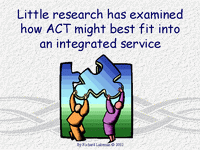 |
|
There is little doubt that ACT is helpful in reducing hospitalisation, improving housing
stability, and possibly contributes to modest improvements in quality of life and psychiatric symptomatology.
However, the research evidence does not elucidate what elements of ACT contribute to improvements or whether or not improvements are sustained over time once ACT services are withdrawn
(Mueser, Bond, Drake, & Resnick, 1998). Furthermore, ACT has largely only been examined in the context of
discrete, well-resourced teams, often comparing outcomes with poorly resourced services. |
Successful ACT programmes described in the literature have also often been implemented as part of well-resourced and planned integrated services. For example Hambridge and Rosen
(1994) described a reduction of 62% in bed occupancy by clients referred to a newly developed mobile community management team in suburban Sydney.
However, this service was also part of an integrated programme that included supervised residences and residential
rehabilitation, a transitional work programme, two community mental health centres with 24 hour mobile crisis services and living skills centres. Such a range of services would be the envy of many regions and beyond the reach of less populace centres. ACT must invariably be adapted to the specific needs of
communities, geographic settings and adapted to the presence and availability of additional services. Little research has been undertaken examining how ACT fits in to a wider integrated service.
The United Kingdom has been slower to adopt ACT. Results of a recent random controlled trial of ACT in the UK have been less impressive than elsewhere. Burns et al.
(1999) randomly assigned 708 psychotic patients to standard case management (case load 30 to
35) and to intensive case management (case load 10 to 15) at four sites. They reported no significant gains in clinical or social functioning in either group at one or two
years, and no significant difference in hospital use between groups (Burns et
al., 1999). It appears that simply reducing caseload does not lead to an improvement in outcomes. It might also be that without careful targeting of interventions to those that might benefit the
most, clients risk being over-serviced without improvement in outcomes. However, in a later study examining effects of case load size Burns et al.
(2000) concluded that "UK standard care contains many of the characteristics of assertive outreach services and differences in outcome may require that greater attention be paid to delivering evidence-based interventions." It matters more what individual case-managers do with their time with clients than how often they see them.
Programme fidelity & the essential ingredients of ACT 
Programme fidelity is the term used to describe conformity to prescribed elements and the absence of non-prescribed elements in a programme. Programme fidelity is particularly important in research in order to ensure that one is comparing similar services i.e. apples with apples. There also comes a point when an intervention or programme deviates so much from recognised elements that it can no longer be said to be that entity. There is some evidence that those programmes that are more faithful to the ACT model have superior outcomes
(McGrew, Bond, Dietzen, & Salyers, 1994; McHugo, Drake, Teague, & Xie, 1999;
Teague, Bond, & Drake, 1998). The Dartmouth Assertive Community Treatment Scale (Teague et
al., 1998) includes the following factors which are indicative of high fidelity in an ACT team:-
Structure and Human Resources:
-
Small caseload (10 or fewer consumers per case manager)
-
Shared caseload (90% or more of consumers have contact with more than one staff member in a given
week)
- Programme meetings (at least 4 per week)
-
Practicing team leader (TL provides direct services at least 50% of the time)
-
Continuity of staff (less than 20% turnover in 2 years)
-
Staff capacity (Programme operated at 95% or more of full staffing in past 12
months)
-
Psychiatrist on staff (At least one full time psychiatrist per 100 consumers)
Nurse on staff (2 or more per 100 consumers)
-
Substance abuse and vocational specialist on staff
-
Programme size (Is of sufficient absolute size to provide the necessary staffing diversity and coverage
... at least 10 FTEs)
Organisational boundaries:
-
Explicit admission criteria
Intake rate Ė low
-
Full responsibility for treatment services
-
Responsibility for crisis services (24 hr coverage)
-
Responsibility for hospital admissions (95% of admissions are initiated through the
programme)
-
Responsibility for discharge planning (95% of discharges are planned jointly by the
programme)
-
No time limit on services
Nature of services:
-
In vivo (80% of service time in the community)
-
No dropout policy (95% retention over 12 months)
-
Assertive engagement (outreach services)
-
Intensity of services (as much as is needed; 2 hours or more per week)
-
Frequency of contact (on average 4 or more times per week)
-
Work with support system
-
Individualised substance abuse treatment
-
Dual disorder treatment groups
-
Consumers are employed on the treatment team
Most programmes that would claim to be ACT services deviate from these specifications in some way.
Burns, Fioritti, Holloway, Malm, and Rossler (2001) suggest that a significant influence of national culture is evident both in the acceptability of case management and in approaches to researching and undertaking it. This is also likely to be the case across Australasia. Experts disagree on the relative importance of different components
(see: McGrew & Bond, 1995; Schaedle & Epstein, 2000). For example, twenty-four hour care by a dedicated team may be an expensive luxury and duplication of service when alternative crisis services are available. In early implementations of ACT avoidance of office or clinic visits was pursued
pedantically, however avoidance of office visits may be better thought of as an outcome of assertive
outreach, rather than an end in itself. The need to have one team member as a co-ordinator and a team approach are often considered important structural elements of ACT programmes
(McGrew & Bond, 1995).
Targeting and triage 
One general principle of ACT is that the service is targeted to those who might most benefit from it. From itís conception ACT has targeted those perceived as being
"heavy service users" or those with the most intractable symptoms of severe illness and the greatest level of functional impairment.
Kent, Fogarty, and Yellowlees (1995) describe the heavy service user as the 10 to 30 percent of patients who use 50 to 80 percent of resources. Abbott et al.
(1997) undertook a literature review and engaged a panel of
"experts" to arrive at 13 factors, which characterised the heavy service user and qualified them for involvement in a Mobile Intensive Treatment Team
(MITT) service. The Townsville MIT team utilises the instrument and a comprehensive referral for screening potential participants in the programme.
The Mobile Intensive Team Screening Instrument
MITT ENTRY CRITERIA
Mandatory
Ratings
-
To be within the age range of 18-64 and resident within the health district for most of a 6 month period
- To have a major psychiatric condition where the primary diagnosis is not intellectual impairment or drug dependence
- To require constant input of more than weekly contact i.e. actual / potential heavy service users.
- If not regulated, accepting of MITT involvement
Rated Criteria
-
Prolonged, frequent or multiple hospitalisations = 9 (83%)*
-
Unstable accommodation = 8 (67%)*
-
No or few support systems = 7 (67%)*
-
Poor living skills = 6 (100%)*
-
Unable to benefit from existing services because of:-
-
Inability to access independently = 1 (67%)*
-
Lack of insight = 1 (92%)*
-
Lack of motivation = 1 (92%)*
-
Inability to organise him / herself = 1 (75%)*
-
Physical limitations = 1 (8%)*
/ 35 * Percentage of Townsville MITT client referrals at time of writing.
To be considered eligible for MITT services all mandatory criteria must be met and a score of at least 16 out of 35 points needs to be attained. Abbott et al.
(1997) suggested that the tool might be used as an exit-screening instrument e.g. when scores fall below 16 consideration is given to discharging the person from the
service, although the instrument has not been used in this way.
Discharge from ACT 
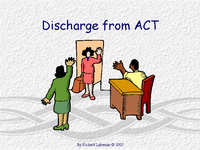 |
|
Discharge from ACT is not an issue that has been examined in sufficient detail to specify rigid criteria. In
practice, a fair amount of clinical judgement based on amongst other things, the nature and type of supports available to the
person, a knowledge of the natural history of the personís illness, stability of insight and
symptoms, compliance with aftercare, and the personís wishes, determine the need for discharge.
A number of people grow beyond the need for ACT, and for others the need is ongoing. Most are likely to require some type of follow-up from mental health services and a lengthy period of shared follow-up with a new case-manager is useful. Abrupt withdrawal of ACT often amounts to an abrupt withdrawal of a key form of stabilising support which can act as a buffer to lifeís stresses. |
Case Example
Eric was a 46 year old man with a diagnosis of paranoid schizophrenia. For many years the focus of his life had been the care of his elderly mother who also prompted him to take his medication. Eric did not have a good relationship with his father during his
childhood, and tenaciously maintained that he was the son of a very important
person, probably a member of a royal family and certainly extremely rich and powerful. He believed that his birth father kept a close eye on him.
However, evil forces sought to prevent his father from making contact with him and enabling him to claim his rightful inheritance. Some time after the death of his mother he had an acute relapse in which he became acutely psychotic. He was convinced that one of his foe had spiked his drink with LSD in a local coffee shop. Following a siege like situation involving the armed defenders squad he was admitted to the acute psychiatric unit and referred to the MIT team after a lengthy admission.
Ericís symptoms stabilised quickly. His case manager visited him often and assisted him with activities of living such as
shopping, and spent time with him walking and riding a bike (Eric wanted to lose
weight). He lived reasonably close to a sympathetic GP practice and his case manager would accompany him to appointments. He was fully compliant with treatment. After about 18 months some pressure was placed on the MIT to discharge clients and accept new referrals. Ericís HoNos scores had improved and he had achieved a clinically significant improvement in LSP scores. He was introduced to a new case manager in the general case management team and discharged in one month. Within two weeks of discharge he had an acute relapse and was admitted to the acute psychiatric unit.
In the absence of further details this vignette might raise many questions about client dependence on MITT
services, the failure to facilitate natural supports, the quality of rehabilitation provided and of planned after care.
However, in my view it best illustrates the provision of ACT as a human undertaking and the importance of supportive relationships in maintaining well-being. Klinkenberg and Calsyn
(1996) describe community support, receipt of aftercare and system responsiveness as the key mediating factors leading to nonrecidivism in vulnerable mentally ill populations. Certainly ACT increases the certainty of aftercare and ought to act to bolster community support for the person and where needed act as a surrogate to natural supports. ACT ought to be responsive not only to gross changes in mental health
status, but to the changing and emerging needs of the person on a day to day basis.
Indeed, these factors ought to be central concerns of a mental health system, not just a dedicated team.
The Mobile Intensive Treatment Team in Townsville 
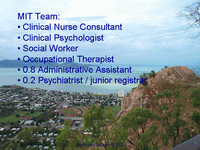 |
|
The Mobile Intensive Treatment Team in Townsville was set up in 1998 with federal funding to provide assertive community treatment to those within the Townsville and Thuringowa Metropolitan areas
(population approximately 135,000). It also had a mandate to case manage people under Project
300, a scheme that targeted resources to assist people who had been hospitalised for long periods to be integrated and treated in the community. Originally the MIT team was a stand-alone service but in 2001 the team was relocated with other community health services and made operationally responsible to a team leader for all adult community mental health services. |
At the time of writing the MIT team in Townsville consisted of a Clinical Nurse
Consultant, Clinical Psychologist, Social Worker, Occupational Therapist, a part time administrative officer with shared duties and a consultant psychiatrist working approximately 0.2 FTE for MITT. The hours of operation are 8-5 Monday to Friday. Referrals are received from within adult mental health
services, and have included zonal inpatient rehabilitation units in Kirwan and Charters
Towers, the acute inpatient unit and the general case management teams. The team is currently responsible for providing care and treatment to approximately 30 people.
Most clients have a diagnosis of a psychotic disorder although several have a diagnosis of bipolar affective disorder or a primary personality disorder. Most have some other confounding co-morbidity such as an acquired brain
injury, intellectual handicap, substance use disorder, or borderline personality traits. A forensic history is common. The majority also had few supportive
relationships, had frequent or lengthy hospital admissions, and had unstable accommodation on referral.
Unique contextual factors
Townsville is a multicultural town with a relatively young population. It has the largest urban concentration of Aboriginal and Torres Straight Islanders outside of
Darwin. It is located in the tropics and as such certain health practices such as maintaining personal hygiene and rubbish disposal are important to maintain personal and public
health. Those on pensions are entitled to subsidised or public housing, cheaper public
transport, educational subsidies, childcare subsidies, medication subsidies and free dental treatment.
However, a complicated bureaucracy administers the welfare system and many people find it hard to access entitlements.
Intravenous amphetamine use is common.
Homelessness is a problem in Townsville. It can take up to 5 years to access public housing and accessing private rental accommodation is expensive and difficult. People may be permanently
"blacklisted" because of non-compliance with tenancy agreements. Consequently many people live in caravan
parks, boarding houses, or on the streets.
There is no professionally supported or supervised accommodation for people with mental illness outside of the rehabilitation units.
A large number of non-government organizations are publicly funded to provide various support services.
Fidelity to ACT model in Townsville
In many ways the Townsville MIT is faithful to the ACT model:
- Most services are provided as outreach.
- The team meets at least 3 times a week to discuss the entire case list and formal reviews occur at least weekly involving all clinical staff.
- Client reviews occur at least every three months but usually more frequently and involve the collation of outcome data.
- Case managers know all clients supported by MIT and have frequent contact with clients not on their case list. All staff leave is covered from within the team.
- Case managers are concerned about community development and all are involved with different causes.
- Case managers are readily able to facilitate admission to the acute inpatient unit should the need arise and are active in discharge planning.
- Clients are able to see a consultant psychiatrist frequently.
Deviation from ACT model in Townsville
The MIT team deviates from the ACT model in a number of significant ways:
-
No extended hours support by the MIT team - On request the Intake and Assessment Team has provided telephone contact to people out of office hours and on weekends.
- Some aftercare is brokered to nursing agencies.
- Whilst adequate for most people, the lack of after hours routine face to face clinical support has contributed to the rehospitalisation of a number of MIT clients.
-
There is presently no designated co-ordinator of MIT who carries a clinical workload.
-
Support services are brokered out Ė Lifestyle, recreational and vocational support for people with disabilities are funded by departments other than health and brokered to a number of support agencies. An elaborate and lengthy referral process for lifestyle support is required and often initiated by MIT. Acceptance can take many months and only one in five applications assessed as high priority are presently funded. Emergency funding for 100 hours support can be obtained but many clients receive inadequate or no lifestyle support. MIT liases closely with agencies that provide support to MIT clients and attempts to provide whatever support is needed to those without packages.
-
Staff Turnover Ė Two of the case managers within MIT are in acting rather than permanent positions.
-
No consumers or support staff are employed by the MIT team although close and mutually respectful relationships are maintained with non-government support organizations such as the Schizophrenia Fellowship and Adult Relatives and Friends of People with Mental Illness
(ARAFMI).
-
Rapid response Ė Previously MIT enjoyed dedicated administrative assistance and the use of answer phone facilities. Since relocating the MIT team has lost these
facilities, which mean that case managers cannot be contacted as quickly.
Outcomes and Evaluation
Specific desirable outcomes are negotiated with each client throughout involvement with the MIT team. Measures such as the Health of the Nation Outcome Scale
(HoNOS), Life Skills Profile (LSP) and Global Assessment of Functioning (GAF) are collated regularly for all clients at least 3 monthly. Other measures such as the Positive and Negative Syndrome Scale
(PANSS) are used as required. The majority of clients have shown clinically significant improvements in functioning
(LSP improvement of >16) and the frequency or length of hospitalisation for acute reasons has diminished. One client has
"dropped out" of the service over the last twelve months (left town), 3 were readmitted to residential rehabilitation largely due to the lack of extended hours face-to-face
support, and another is presently incarcerated after committing arson. Five have been discharged to other services for follow-up.
A survey of clients, family members and non-government organizations was undertaken using semi-structured interviews and thematic analysis early in 2001. This indicated a high degree of satisfaction with the services
provided, particularly relative to other services. Clients commented on their satisfaction with the availability of their case manager and how the case manager would offer assistance with activities of daily living such as shopping. Families and non-government organizations commented positively about the quick response to their concerns from MIT and how they were confident that the person would be followed up.
The work of the case manager in an ACT team 
The success of an ACT programme is dependent on the right mix of people and skills.What case managers actually do with clients has not been investigated in great detail
(see: Bjorkman & Hansson, 2000). There is considerable support for psychiatrists, nurses and social workers being on ACT
teams, but also increasing support for vocational and substance abuse experts being available for
consultation, if not as full team members. Often people have complex medical needs and nurses are well suited to bridging roles that are required. In the United States it appears that providing most clinical services from within the team is a priority. In part this is due to substance abusing clients having poorer outcomes regardless of intervention
(Havassy, Shopshire, & Quigley, 2000), and evidence that brokerage of services is related to decreased satisfaction with service
(Huxley & Warner, 1992). Of paramount importance is that ACT workers are suitably experienced and skilled to provide a full range of mental health services.
What ACT case managers actually do with clients is dependent on what needs to be
done, thus people are likely to assume numerous roles in relation to the person. Unlike other form of clinical case management the boundaries of involvement tend to be loose rather than tight. The following case example illustrates some of the interventions that might be provided:
Case Example Omitted - Contact Richard if you would like a copy of the full paper.
The above provides just a small sample of roles that may be assumed by an ACT case
manager, none of which are particularly unique. Case managers require a depth of knowledge about medical
treatments, and well-developed problem solving and counselling skills. It also often requires skills in appraising risk so a degree of experience in mental health services is needed. Unlike programme
specifications, the particular mix of roles that may be assumed by case managers will be unique for each individual.
Ethical problems associated with ACT 
 |
|
A cursory review of the literature relating to ACT might suggest that the holy grail of mental health services has been found. That
is, a way of configuring mental health service provision, which achieves good
outcomes, is mostly acceptable to families and consumers, and reduces hospitalization.
However, it is possible that an ACT services can be ethically bankrupt, whilst being faithful to prescribed standards. At the very least the nature of ACT work is a profoundly ethical undertaking and clear conflicts often arise between beneficence and
autonomy, between beneficence and nonmaleficence, and between nonmaleficence to the individual and to the community
(Stovall, 2001). |
Many of the ethical problems arising in ACT are common to mental health care generally but are particularly problematic in ACT due to the persistent and intrusive nature of outreach. ACT has its routes in institutional hospital care in which staff were a permanent and visible part of every aspect of peopleís lives. ACT was conceived of originally as
"a hospital without walls" and has many elements of institutional care despite such care having lost favour in recent years. At the very least it is considerably more intrusive than office or clinic based approaches in which people may exercise the choice not to attend
appointments, to disengage from services and can at least enjoy the relative sanctuary of places free from the surveillance of mental health professionals. Control over medication and money are often of central concern to people with chronic mental illness and when problems arise in these areas the result can be
incarceration, hospitalization or homelessness (Stovall, 2001).
|
ACT can and sometimes does impinge on the personal autonomy of clients. The Program of Assertive Community Treatment
(PACT) in the United States has met with some considerable opposition from anti-psychiatry groups. Concerns
centre around PACT as a coercive vehicle to enforce medication compliance, particularly when combined with involuntary outpatient commitment. Support Coalition International
(2001) likens PACT to a Trojan horse: "This
wraparound" service, as it's sometimes called, looks pretty on the outside, but inside you can find a lot of
"medication militia" hiding out". ACT teams usually have a biomedical bias in which medication compliance and symptom monitoring are frequently seen to be a cornerstone of treatment and can give rise to a paternalistic approach to care
(Spindel & Nugent, 2001). When a biomedical conceptualisation of problems becomes the sole focus or when carried to extreme the benevolent paternalism of psychiatry can become malevolent. Even when treatment appears to be negotiated rather than
enforced, the voluntariness of treatment must be acknowledged as shaky when the power to enforce treatment involuntarily rests with mental health services. Coercive strategies to enforce compliance are always ethically problematic. |
|
 |
It is a undeniable that psychiatry has a social control function (Lakeman & Curzon,
1997) which in relation to people receiving ACT services creates tensions between the teamís allegiance to the
person, their family and to wider society. One often unacknowledged goal of psychiatric treatment is to minimise the risks posed to society by the personís behaviour. Those referred to ACT are more likely to have a forensic
history, be homeless, impoverished, unemployed and on the margins of society. Extreme caution must be exercised to ensure that ACT doesnít further subjugate already marginalised groups.
Solomon, Draine, and Meyerson (1994) suggest that case management may easily deteriorate into providing monitoring rather than rehabilitative services and thus may facilitate reincarceration. It has been suggested that limit setting is a feature of ACT which sets it apart from other programmes
(Neale & Rosenheck, 2000) yet clearly this must be balanced with the provision of care. Health professionals must balance these conflicting demands and interests in their day-to-day work. They also have a duty to address the wider social justice issues which lead to marginalisation of people in the first place; to attempt to create a mental health
"care" system (Lakeman, 1998) rather than merely providing a service which is palliative to a sick society.
A further significant ethical problem arises from the exclusive nature of ACT and itís relationship with other services. A considerable number of people who might benefit from ACT are denied the service because of stringent entry criteria. To some extent ACT as it is located within many services is the ambulance at the bottom of the cliff and can reflect
"too much to late". If an ACT approach is implemented earlier many problems might be avoided or become less entrenched. ACT embodies many of the
principles, which ought to be a feature of wider community mental health
services, for example, a commitment to stick with people for as long as is needed and to do what is needed.
The ethical problems inherent in ACT are not insurmountable. Szmukler (1999) suggests that
"...approaches to resolving ethical problems include increasing patient involvement in their
care, clarifying the grounds for 'paternalistic' interventions, and re-examining grounds for acting to reduce the risk of harm to others". In practice the resolution of ethical problems must commence from a sensitivity to situations as problematic
(Lakeman, 1999). Christensen (1995, p.1217) identifies further virtues that ought to influence our ethical reasoning:
Compassion which "... impels us to stand with our clients and take seriously the reality of their pain and confusion."
Humility which "... reminds us of our humanness as persons and our fallibility as health care providers."
Fidelity which "... inclines us to not easily abandon those whom we have forged commitments to help. Fidelity serves to remind us that clients have a claim on us that endures even when they refuse the treatment we offer."
The experiences of implementing ACT over 30 years, and the ethical problems inherent in it can provide some lessons to assist in the development of a unifying philosophy of community mental health.
Towards assertive community care 
Whilst not a new phenomenon, many mental health services have a "Spin them out when they stop spinning out" response to people with long term and relatively enduring problems of mental
health, that is only dealing with the person in an acute phase of illness rather than having a longer term rehabilitation focus. The goal has become to get the person
"off the books" as soon as possible. The word "care" has been lost from the lexicon of many
services, and notion of "continuing care" has become highly unfashionable.
"General case management teams" often become disgruntled with being unable to provide what they know might be helpful and a negative consequence is an increased emphasis on gate keeping and boundary enforcement rather than provision of care or therapy. ACT provides a broad philosophy of practice that ought to be adopted by all community mental health
services, which can counter these disturbing and negative trends.
ACT, like community mental health services is in a state of evolution.
Historically, it has its roots in ensuring treatment but over time the best examples of ACT have evolved into systems of care which go well beyond merely providing medical treatment. To use a Buddhist metaphor it reflects a middle way of psychiatric services and is a
"skillful" activity in both the technical and ethical sense. Programme specifications are not ends in
themselves, but assist in mandating the conditions for ACT to take place.
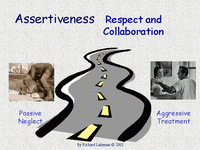 |
|
Assertiveness precludes a passive neglect of people with mental illness. It means not allowing a person to fall through the cracks and knowing when to act and when to stand by. This is not
something, which is easily prescribed and requires skills in engagement,
negotiation, knowledge of good mental health practices and ethical sensitivity. Neither should ACT be aggressive and ride rough shod over peopleís human rights in the enforcement of treatment. Stovall
(2001) points out that establishing long term relationships based on respect fosters collaboration and minimises the utilisation of coercive approaches. |
|
Community in ACT is both the location of care and is also acknowledged as the source of natural support and sustenance for the person. ACT should aim to develop the capacity of families and communities to provide care and if necessary to provide that care from within the ACT service for as long as is needed. |
|
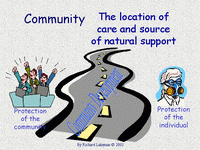 |
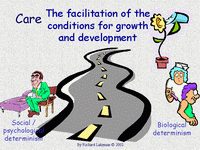 |
|
Treatment in ACT not only entails medical treatment for mental illness but involves care in the broader sense. It involves building on the strengths of the individual and the community to assist in the negotiation of problems of everyday living. As with all good mental health care the focus should be on growth and attempting to facilitate the right conditions for growth to occur so that the person and his or her family are best able to negotiate everyday living themselves. Having clear treatment goals which are negotiated with the person provide a context for interactions with the team. |
ACT in the manner described above is by no means a new concept and harks back to principles of good nursing and human service. It is or ought to be founded on respect for people. ACT represents a set of ideals and an orientation to working which should form the heart of all mental health service delivery.
References 
Abbott, S., Smith, S., Clarke, R., Curson, C., De Souza Gomes, J., Heslop, K.,
Trainer, E., & Yellowlees, P. (1997). Who is a heavy service user?
Preliminary development of a screening instrument for prospective consumers of a
mobile intensive treatment team. Aust N Z J Psychiatry, 31(5), 744-750.
Bjorkman, T., & Hansson, L. (2000). What do case managers do? An
investigation of case manager interventions and their relationship to client
outcome. Soc Psychiatry Psychiatr Epidemiol, 35(1), 43-50.
Burns, T. (1997). Case management, care management and care programming.
British Journal of Psychiatry, 170, 393-395. Burns, T. (2001). To outreach or
not to outreach. Journal of Forensic Psychiatry, 12(1), 13-17.
Burns, T., Creed, F., Fahy, T., Thompson, S., Tyrer, P., & White, I.
(1999). Intensive versus standard case management for severe psychotic illness:
a randomised trial. UK 700 Group. Lancet, 353(9171), 2185-2189.
Burns, T., Fiander, M., Kent, A., Ukoumunne, O. C., Byford, S., Fahy, T.,
& Kumar, K. R. (2000). Effects of case-load size on the process of care of
patients with severe psychotic illness. Report from the UK700 trial. Br J
Psychiatry, 177, 427-433.
Burns, T., Fioritti, A., Holloway, F., Malm, U., & Rossler, W. (2001).
Case management and assertive community treatment in Europe. Psychiatr Serv,
52(5), 631-636.
Carolla, B. (1998). Falling through the cracks: Our nationís continued
failure to provide effective care and treatment for individuals with the most
severe mental illnesses. National Alliance of the Mentally Ill. Retrieved
13-10-01, 2001, from the World Wide Web: http://www.nami.org/pressroom/981006215423.html
Christensen, R. C. (1995). The ethics of treating the "untreatable"
(Editorial). Psychiatric Services, 46(12), 1217. Dixon, L. (2000). Assertive
community treatment: twenty-five years of gold. Psychiatr Serv, 51(6),
759-765.
Gold Award. (2000). A community treatment program. Psychiatric Services,
51(6), 755-758. Hambridge, J. A., & Rosen, A. (1994). Assertive community
treatment for the seriously mentally ill in suburban Sydney: a programme
description and evaluation. Aust N Z J Psychiatry, 28(3), 438-445.
Havassy, B. E., Shopshire, M. S., & Quigley, L. A. (2000). Effects of
substance dependence on outcomes of patients in a randomized trial of two case
management models. Psychiatr Serv, 51(5), 639-644.
Hoult, J., Reynolds, I., Charbonneau-Powis, M., Coles, P., & Briggs, J.
(1981). A controlled study of psychiatric hospital versus community treatment -
the effect on relatives. Aust N Z J Psychiatry, 15(4), 323-328.
Huxley, P., & Warner, R. (1992). Case management, quality of life, and
satisfaction with services of long-term psychiatric patients. Hosp Community
Psychiatry, 43(8), 799-802.
Kent, S., Fogarty, M., & Yellowlees, P. (1995). A review of studies of
heavy users of psychiatric services. Psychiatr Serv, 46(12), 1247-1253.
Klinkenberg, W. D., & Calsyn, R. J. (1996). Predictors of receipt of
aftercare and recidivism among persons with severe mental illness: a review.
Psychiatr Serv, 47(5), 487-496.
Lakeman, R. (1998). Beyond glass houses in the desert: a case for a mental
health 'care' system. Journal of Psychiatric and Mental Health Nursing, 5(4),
319-328.
Lakeman, R. (1999). Commentary on 'Where care meets treatment: common ethical
conflicts in psychiatric nursing'. In P. Barker (Ed.), The philosophy and
practice of psychiatric nursing (pp. 213-216). Edinburgh: Churchill
Livingstone.
Lakeman, R., & Curzon, B. (1997). Society, disturbance and mental
illness. In P. Barker & B. Davidson (Eds.), Ethical Strife (pp. 26-38).
London: Arnold.
Marshall, M., Gray, A., Lockwood, A., & Green, R. (2000). Case management
for people with severe mental disorders. Cochrane Database Syst Rev(2),
CD000050.
Marshall, M., & Lockwood, A. (2000). Assertive community treatment for
people with severe mental disorders. Cochrane Database Syst Rev(2),
CD001089.
McGrew, J. H., & Bond, G. R. (1995). Critical ingredients of assertive
community treatment: judgments of the experts. J Ment Health Adm, 22(2),
113-125.
McGrew, J. H., Bond, G. R., Dietzen, L., & Salyers, M. (1994). Measuring
the fidelity of implementation of a mental health program model. J Consult Clin
Psychol, 62(4), 670-678.
McHugo, G. J., Drake, R. E., Teague, G. B., & Xie, H. (1999). Fidelity to
assertive community treatment and client outcomes in the New Hampshire dual
disorders study. Psychiatr Serv, 50(6), 818-824.
Mueser, K. T., Bond, G. R., Drake, R. E., & Resnick, S. G. (1998). Models
of community care for severe mental illness: a review of research on case
management. Schizophr Bull, 24(1), 37-74.
Neale, M. S., & Rosenheck, R. A. (2000). Therapeutic limit setting in an
assertive community treatment program. Psychiatric Services, 51, 499-505.
Phillips, S. D., Burns, B. J., Edgar, E. R., Mueser, K. T., Linkins, K. W.,
Rosenheck, R. A., Drake, R. E., & McDonel Herr, E. C. (2001). Moving
assertive community treatment into standard practice. Psychiatr Serv, 52(6),
771-779.
Schaedle, R. W., & Epstein, I. (2000). Specifying intensive case
management: a multiple perspective approach. Ment Health Serv Res, 2(2),
95-105.
Solomon, P., Draine, J., & Meyerson, A. (1994). Jail recidivism and
receipt of community mental health services. Hosp Community Psychiatry, 45(8),
793-797.
Spindel, P., & Nugent, J. (2001). The trouble with PACT: Questionning the
increasing use of assertive community treatment teams in community mental
health. Retrieved 14.02.01, 2001, from the World Wide Web: http://akmhcweb.org/Articles/pact.htm
Stovall, J. (2001). Is assertive community treatment ethical care? Harv Rev
Psychiatry, 9(3), 139-143. Support Coalition International. (2001). Mental
health workers bring psychiatric drugs to your home to assure compliance: Stop
PACT! Retrieved 20-10-01, 2001, from the World Wide Web: http://www.mindfreedom.org/mindfreedom/ioc/workers.shtml
Szmukler, G. (1999). Ethics in community psychiatry. Aust N Z J Psychiatry,
33(3), 328-338. Teague, G. B., Bond, G. R., & Drake, R. E. (1998). Program
fidelity in assertive community treatment: development and use of a measure. Am
J Orthopsychiatry, 68(2), 216-232.
Ziguras, S. J., & Stuart, G. W. (2000). A meta-analysis of the
effectiveness of mental health case management over 20 years. Psychiatr Serv,
51(11), 1410-1421.
Citations 
This paper was originally prepared for:
Lakeman, R. (2001). Getting our ACT together (Invited workshop presenter).
Does Community Care Work? An International Mental Health Conference, Wanganui
Convention Centre, NZ, Good Health Wanganui, 21-22nd November.
It was amended and presented at:
Lakeman, R. (2002). Towards Assertive Community Care. he North
Queensland Sub-branch of the Australian and New Zealand College of Mental
Health Nurses Winter Symposium, Rydges Capricorn International Resort, Yeppoon,
18-19 May.
This page last updated 12/12/2002
